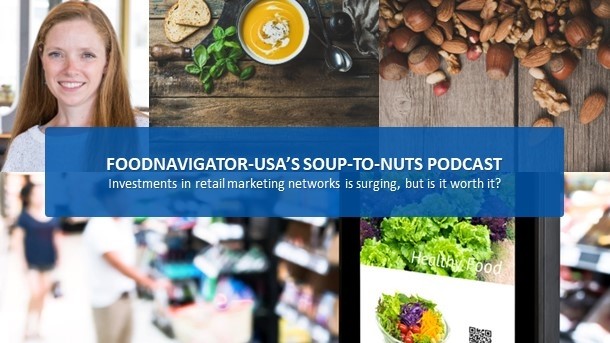Soup-To-Nuts Podcast: Investments in retail media are surging, but is it worth it?

According to recent research by McKinsey, the $45 billion US retail media market “is surging,” with 73% of advertisers saying they will spend more on RMNs in the next 12 months, and CPG and grocery stakeholders planning to increase their spend with RMNs by 53% in the next year. As a result, the Interactive Advertising Bureau, which has a mission to help media and marketing industries thrive in the digital economy, expects retail media to more than double in the next five years to $107b.
In this episode of FoodNavigator-USA’s Soup-To-Nuts podcast, Paul Brenner, the senior vice president of retail media and partnerships at Vibenomics, a Mood Media Company, explains the appeal of RMNs, including how in-store technology innovations are propelling this transformation, and what they can offer compared to other advertising options, including access to consumers who are in a shopping mindset and increasingly difficult to obtain first-party data.
[Editor’s Note: Never miss an episode of FoodNavigator-USA’s Soup-To-Nuts podcast – subscribe today.]
What is behind the growth?
Much of the current interest in and recent evolution of retail media network advertising, and in particular the demand for solutions in-store, comes from CPG companies responding to shifting shopping habits, which Brenner describes as a “whipsaw.”
“The retail media market share has just exploded. It is almost unrealistic when you look at it as equivalent to the growth of search and social. … Retail media is quickly approaching and surpassing linear television broadcast,” and much of the growth is due to consumers embracing omnichannel shopping, he said.
He explained when consumers moved to online shopping in mass during the pandemic, retailers had an opportunity to build out their websites and work with brands to position products on their virtual shelves. But as shoppers went back to brick-and-mortar, players needed to pivot again to place ads closer to the consumer – ultimately resulting in an omnichannel marketing opportunity that demanded a more programmatic approach to advertising.
Because RMNs are growing so quickly and are a new advertising strategy for many, Brenner says most retailers and brands are still trying to suss out the best approach to reach consumers.
He says a good starting point for reaching consumers in-store is offering more dynamic multi-media, like audio or in-store screens, and personalized advertising, which can help cut through the clutter imposed by more traditional and static printed advertising materials.
“We know that audio works, because we get good results for advertisers and its contextual and targeted to demographics … or geographies,” he said.
Likewise, in store screens can bring together the online experience and in-store experience so that omni-channel shopping is more fluid.
Top challenges include overcoming stereotypes about in-store advertising
While retailer marketing networks are gathering momentum, they still face significant challenges that may deter brands from engaging with in-store advertising. For example, Brenner notes, many brands have out-dated ideas of what in-store advertising can be or are unclear on how to incorporate it into their joint business plans.
“There is such a stigma of what in-store used to be. It was entirely static with a shopper, marketing, shelf tags,” all of which required coordination to put in store and had to be planned far in advance, he said.
The other challenge is helping brands and retailers understand dynamic in-store advertising fits within their existing joint business plans as part of the larger programmatic promotional planning.
Once brands understand that in-store advertising is another option, Brenner says the handcuffs will come off and they will have more flexibility to try new solutions.
RMNs offer personalization capabilities, retargeting in cookie-less world
Retailer marketing networks can further amplify the impact of technological innovations in advertising and increase their appeal to brands by layering in their customers’ purchase data – which Brenner says can help fill the void created when Apple de facto killed identifiers for advertisers that previously allowed brands to understand who clicked on an ad and if an ad led to a purchase.
He explained that retailers have opt-in loyalty programs with participation as high as 95%, which provides them with data they can use to effectively retarget advertising.
That retargeting may not be as robust as it was with cookies, but it is effective because it touches people when and where they are shopping.
How Vibenomics creates an effective in-store campaign
So, what might an in-store campaign with RMN look like? Brenner says they can be diverse as the selection of products in any given store, but they all usually begin with an assessment of what is available where and how shoppers in that store typically behave.
For example, Brenner says, if a cereal brand wanted to create an in-store marketing campaign the RMN would consider the target demographics, where and when they shop, which stores carry the specific SKU and then craft messaging tailored for those consumers in those stores that would air or appear at the times they typically shop. These are then linked to other touchpoints and creatives for a cohesive campaign.
“Usually at the end, we’ll do some kind of study with them or they’ll use existing data they get … from the retail networks … to make sure that they can prove they got a result from it,” he added.
Brenner recommends that brands and retailers interested in learning more about the potential of RMNs and how best to maximize their impact should download IAB’s retail media buyer’s guide published in July and IAB’s retail media measurement guidelines published last month which promises “uniformity and credibility” in evaluating campaign performance to better optimize investments effectively.














